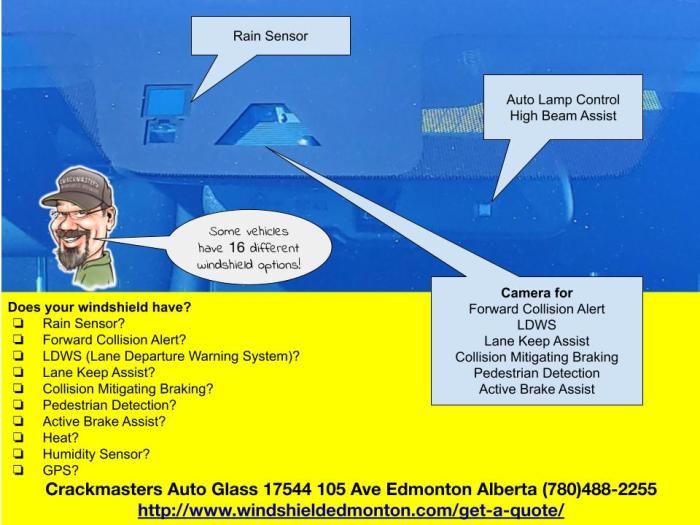What are the equipment requirements for windshields and side windows? These components play a crucial role in ensuring the safety and visibility of vehicles, adhering to stringent standards and regulations. This article delves into the specifications, materials, and manufacturing processes involved in meeting these requirements, providing a comprehensive understanding of the equipment essential for optimal vehicle performance.
From the thickness and composition of glass to advanced technologies like heated and tinted windshields, we explore the intricacies of these essential components. We also examine the impact resistance and optical properties of side windows, ensuring both driver visibility and passenger protection.
By understanding the equipment requirements for windshields and side windows, we gain a deeper appreciation for the safety and functionality of our vehicles.
Windshield Requirements

Windshields are essential components of vehicles, providing protection from the elements, debris, and other hazards while driving. They also play a crucial role in ensuring driver visibility and overall safety.
Specifications for Windshield Glass
- Thickness:Windshields typically have a thickness ranging from 4 to 6 millimeters.
- Composition:Windshields are primarily made of laminated glass, which consists of two layers of glass with a layer of polyvinyl butyral (PVB) in between.
Safety Standards and Regulations, What are the equipment requirements for windshields and side windows
- Federal Motor Vehicle Safety Standard (FMVSS) 205:This standard establishes minimum requirements for windshield glazing materials, including impact resistance, optical clarity, and light transmittance.
- American National Standards Institute (ANSI) Z26.1:This standard provides guidelines for the safety glazing of motor vehicles, including windshields.
Optical Requirements
- Clarity:Windshields must provide clear and undistorted vision for the driver.
- Distortion:Windshields must meet specific distortion limits to ensure accurate perception of objects outside the vehicle.
Advanced Windshield Technologies
- Heated Windshields:These windshields have heating elements embedded within the glass, allowing for rapid defrosting and de-icing in cold weather.
- Tinted Windshields:Tinted windshields reduce glare and solar heat gain, improving driver comfort and visibility.
- Laminated Windshields:Laminated windshields consist of multiple layers of glass bonded together with a plastic interlayer, providing increased impact resistance and preventing glass shards from scattering in the event of breakage.
Side Window Requirements: What Are The Equipment Requirements For Windshields And Side Windows

Side windows are equally important for vehicle safety and comfort, providing visibility for passengers and drivers, allowing for ventilation, and protecting against external elements.
Functions of Side Windows
- Visibility:Side windows provide drivers and passengers with a clear view of their surroundings, aiding in safe driving and situational awareness.
- Ventilation:Side windows can be opened or lowered to allow fresh air circulation and ventilation within the vehicle.
- Protection:Side windows shield occupants from wind, rain, and other environmental hazards.
Types of Side Window Glass
- Tempered Glass:Tempered glass is strengthened through a heat treatment process, making it highly resistant to breakage and shattering.
- Laminated Glass:Laminated glass, similar to windshields, consists of multiple layers of glass bonded with a plastic interlayer, providing increased impact resistance and preventing glass shards from scattering.
Safety Standards and Regulations, What are the equipment requirements for windshields and side windows
- FMVSS 219:This standard sets requirements for side window glazing materials, including impact resistance and optical clarity.
- ANSI Z26.1:This standard also provides guidelines for the safety glazing of side windows.
Impact and Shatter Resistance
- Impact Resistance:Side windows must withstand the impact of small objects, such as stones or debris, without breaking or shattering.
- Shatter Resistance:In the event of breakage, side windows must not shatter into sharp fragments that could cause injury to occupants.
Optical Requirements
- Visibility:Side windows must provide clear and undistorted vision for both drivers and passengers.
- Glare Reduction:Side windows often have tinted or coated surfaces to reduce glare from the sun, improving visibility and reducing eye strain.
FAQ Guide
What is the purpose of a windshield?
Windshields provide a clear field of vision for drivers, protect occupants from wind and debris, and contribute to the structural integrity of the vehicle.
What is the difference between tempered and laminated glass?
Tempered glass is stronger but shatters into small pieces upon impact, while laminated glass has a layer of plastic between two layers of glass, preventing shattering and providing increased safety.
What are the optical requirements for windshields?
Windshields must meet specific standards for clarity, distortion, and glare reduction to ensure optimal visibility for drivers.
How are windshields and side windows installed?
Installation involves specialized tools and techniques to ensure a secure and leak-proof fit, adhering to industry standards and safety regulations.


